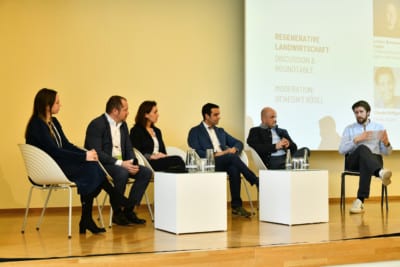
29. January 2020
Regenerative agriculture: It’s not about “conventional or organic”
A review of the discussion on regenerative agriculture at Farm & Food 2020
A wide variety of application examples illustrate how diverse regenerative agriculture can be: Pioneers from Germany and the USA show how the system can be adapted to the respective farm.
Hosted by Benedikt Bösel, Gut & Bösel, the discussion was led by Georg Goeres, Indigo. Louisa Burwood Taylor, AgFunder News. Claudia Päffken, TIMAC AGRO. Adrian Ferrero, Biome Makers. Michael Reber, Innovative Agriculture Reber.
By Laura von Ketteler and Sarah Liebigt
“Regenerative agriculture is a form of land use in which we try to improve the soil and increase biodiversity through use. Instead of merely fighting or avoiding the symptoms of our prevailing production model, we can also try to change the causes through technology,” said Benedikt Bösel.
“Because of the low rainfall, we had to take a new direction with our farm (Gut & Bösel, A.d.R.). That’s why we are looking worldwide for players who think differently. We are trying to implement new methods on our farm and see how they work and how we can scale them,” Bösel said at the beginning of the discussion. After the introduction, Bösel asked the participants to join the podium.
The discussion about agriculture was too much “either or”, Georg Goeres, Indigo, stated. A new type of agriculture must not only be organic. “We must move towards using less and less synthetic materials. For him, the agriculture of the future is a combination of improving the soil and using technology in an affordable way.
Five years ago, Michael Reber started looking for alternatives. The most important thing is that his company becomes economically successful. “The most important thing is to improve the water storage capacity of my soil. “The farmers have to earn money again. Without being paid fairly for what we do, nothing else makes sense.”
How has the transition worked over time? Especially financially?
“The fact is that we are investing in our soil and therefore we have to make some cuts economically”, says Reber. “Another problem is that we lease 85 percent of our land. We always have to get the landlords on board.” For him it is important to get financial support during the time of the change to new methods.
“Timac creates solutions for the plant nutrition, more efficient than other fertilizers, it especially helps with the nutrition uptake”, states Claudia Paeffgen. “In Addition we support the Farmers with Marketing concepts and ways of communication. We see the main challenges of the farmersin : Being sustainably efficient. We act as a partner in social challanges: We help farmers to be transparent, Farmers can invite press and communicate what they are doing well.”
“We have to get away from working against biology or against nature and work with it,” Adrian Ferrero said during the discussion. His company Biome Makers has developed a system for measuring changes in the ecosystem and the impact on soil functionality. Farmers receive a Metrix to better understand the microbiome in their soil. By collecting data about the soil and its impact on soil, farmers can better understand and work with it.

Louisa Burwood-Taylor, Agfunder News, reported that she first came across investment funds for renewable agricultural methods in 2013, but outside Europe. Now she sees them as a global movement. In the United States, she said, there are leaders like Gabe Brown and now some investment funds that are investing in renewable agriculture.
Bösel said that regenerative agriculture had long been regarded as a romantic form of agriculture. However, many now agree that it can indeed be a decisive part of future agriculture. “We need to combine it with technology,” said Burwood-Taylor. “I also think regenerative systems can be combined with GMOs.”
For example, how does Indigo use technology?
Goeres: “The opportunity is huge and it is now! Execution is the key.” Indigo, for example, has set up a microbiological research program that offers farmers alternatives. With the Terraton Initiative, Indigo has found a way to financially reward farmers who improve their soil. “The farms are monitored, using modern technology like satellites,” Goeres said.
How scalable is regenerative agriculture, why doesn’t everyone do it?
The transfer of knowledge is crucial here, says Michael Reber. In general education, he says, there are no answers to climate change and droughts and banned substances. “At first I didn’t take regenerative agriculture seriously. But the problem is that we have to position ourselves somewhere between organic and conventional agriculture, the only two official directions we have in Germany.” Reber started giving seminars to create a knowledge transfer. The participants come from different age groups, work conventionally or organically and come from all over Germany.
For Ferrero it is also important not to divide the farmers. “Think of the soil as a partner and collect data so you can better understand it.” He emphasized the health aspect by involving the consumer. For example, Biome Makers compared organic and conventional apples. The organic apples had a much higher biodiversity, which means more microbes and nutrients, which is good for the immune system. “The potential for scaling up renewable agriculture is enormous,” he was sure. “Sustainability and profitability must be guaranteed.”
From the closing statements on what opportunities the Green Deal can offer
Goeres: “There must be an open discussion about how the money is used. The Green Deal offers 1 trillion dollars for climate protection. Regenerative agriculture would be a good way to use the money. Scalability is also most important, the methods must work on an industrial scale.”
Reber: “We have to start with basic things, the farmer is often left alone with his decisions so far. We have to start the movement from below, everyone has to come together. I wish that in ten years we won’t talk about “conventional or organic” anymore.”
Burwood Taylor: “As a consumer, you should be interested in where your food comes from and how it was produced. As a consumer, you have the opportunity to influence farming practices.”
